I find the Marabou Stork to be one of nature’s most captivating birds. With its statuesque posture and imposing presence, it’s a bird you can’t easily overlook. But most people are not aware of the most intriguing facts about the Marabou Stork.
When you see this bird in the wild, and the chances that you do are high, because they live in several countries, at first you will be like “What a peculiar bird” or “Euhw, it’s ugly”. But that is just scratching the superficial surface because there is so much more to it!
And let us explain why in this article.
The Marabou stork: how to identify and what does it look like?
The Marabou Stork stands tall, with an average height reaching up to 1.5 meters (5 feet). And when it spreads its wings, the span is breathtaking – stretching up to 3.2 meters (11 feet), it rivals some of the largest birds in flight.
The marabou’s color palette is primarily a mix of white belly and grayish/black wings, but it’s the contrasting touches that earn it a second glance. Its head and neck are almost bald, displaying a reddish-pink hue, and during the breeding season, the neck takes on a more vibrant color to attract mates.
Arguably, the most distinctive feature of the marabou stork is the inflatable gular sac hanging from its neck. This sac is not just for show; it plays a crucial role during their courtship displays.
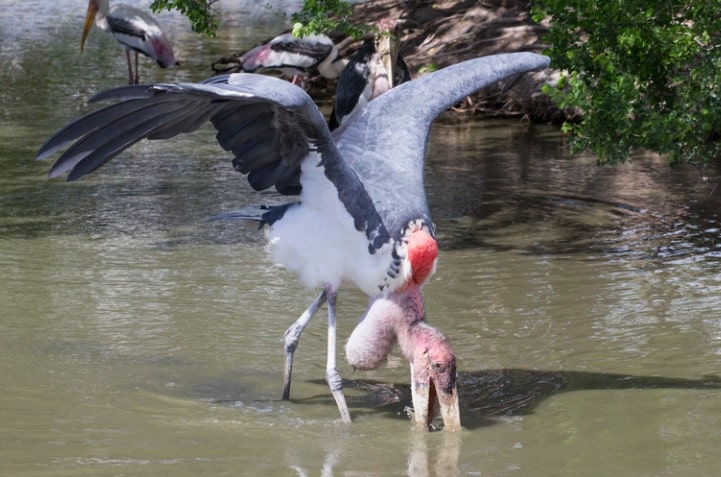
Add to this their long, thin legs that often become coated with their own excrement, turning them white – a process known as ‘urohidrosis‘, believed to help regulate their body temperature.
For those trying to distinguish these birds from other Stork species, focus on the bare head and neck, the sizeable bill that hints at their scavenging habits, and their overall size, which is on the larger end of the stork spectrum.
The best way to identify the marabou stork? Look for an imposing bird that seems like it stepped out of a prehistoric era – powerful, bald, and with a gaze that pierces.
If you place a Marabou Stork next to a human, it can get quite impressive, as shown in this video:
Transitioning from their arresting appearance to where these birds roam reveals their adaptability. Marabou storks are global wanderers found across large swathes of Sub-Saharan Africa. They have a robust presence in the wild, demonstrating a preference for the savannas and wetlands.
The Global Wanderer: Uncovering the Marabou Stork’s Habitat
Imagine a bird that thrives in hot and arid areas, yet is equally at home in the wetlands of Africa. This sets the stage for where you can find the Marabou stork, a global wanderer indeed. Most common across sub-Saharan Africa, these birds have a remarkable capacity for adapting to various environments.
While urban areas are usually not the first place you’d expect to find wildlife, marabou storks seem to make an exception. They are often seen loitering around rubbish dumps or scavenging for scraps, showcasing their opportunistic nature. Quite the sight, isn’t it?
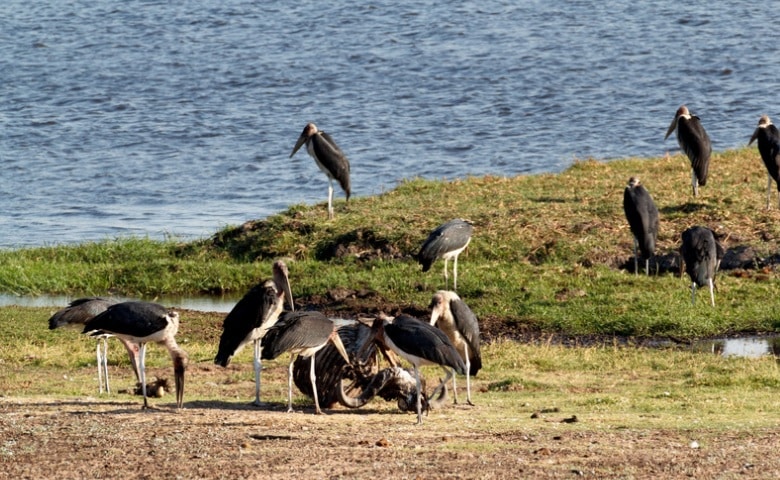
Beyond their city exploits, they’re frequently spotted in grasslands, savannas, and near water bodies like lakes, rivers, and wetlands. They prefer these open areas for a very practical reason: easy access to food. With less coverage, they can spot potential meals from a distance and make their move with that remarkable bill of theirs.
Their ability to flourish in different habitats isn’t solely for survival’s sake; it is also an incredible adaptation feature. Marabou storks utilize thermals to soar high in the sky without expending much energy, which allows them to traverse large areas in search of food or breeding grounds.
Its range includes both East and West Africa, from Senegal and Sudan to South Africa. Some of the countries where Marabou storks are commonly found include Kenya, Tanzania, Uganda, Ethiopia, Nigeria, and South Africa, among others.
Next, we’ll dive into the marabou stork’s diet. It’s not your average bird feeder’s fare by any means, but it is a surprising assortment that keeps them healthy and active in their diverse habitats.
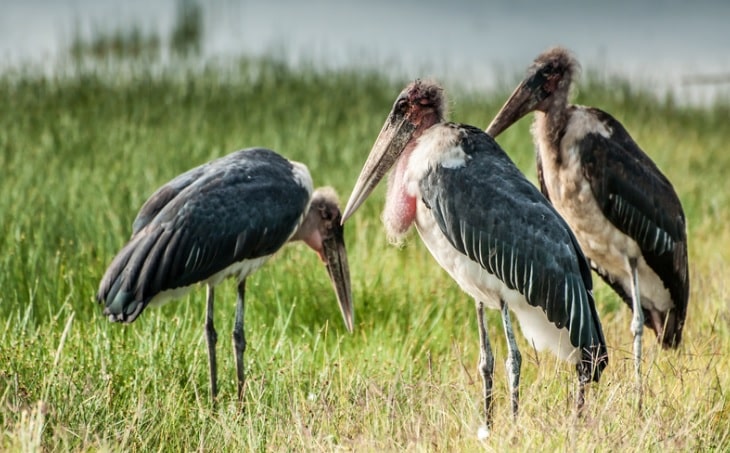
From Scavenging to Hunting: The Marabou Stork’s Diverse Diet
You might not expect it, but the marabou stork is something of a dining connoisseur in the bird world. Not tied down to a monotonous menu, this bird’s diet is as varied as it is fascinating. Let’s explore what fills the plate of these imposing creatures.
Primarily, these birds are scavengers. Think of them as the clean-up crew of the wild, they’re incredibly important for the ecosystem. Carrion is their meal of choice, which includes the carcasses of dead animals. Their knack for scavenging is a crucial natural service, helping to prevent the spread of disease by consuming potentially dangerous decaying matter.
Yet, marabou storks aren’t limited to leftovers. They’ll also actively hunt a variety of prey. From fish snagged out of the water to the small mammals and reptiles that cross their path, these birds don’t shy away from a fresh catch. In areas where humans live, they’ll even grace rubbish dumps in search of edible waste, showcasing their highly adaptable nature.
Marabou storks have also been noted to occasionally indulge in more heinous acts, like stealing eggs from other birds or preying upon the helpless young of other species, much to the chagrin of their feathered peers.
This diverse diet underscores the Marabou stork’s formidable role in their native ecosystems as both hunters and scavengers.
Not a beautiful symphony: the sound of a Marabou stork.
Birds can create stunning pieces of musical art, but this doesn’t really apply to the Marabou stork 🙂
Their sounds include various croaks, grunts, and bill-clattering noises. The vocalizations are often described as deep and guttural. During the breeding season, Marabou Storks may engage in vocal displays as part of their courtship behavior.
Their vocal repertoire may also include hissing and other harsh sounds.
Feathers in Fashion: Understanding ‘Marabou Stork Feathers’ Popularity
I find it quite intriguing how certain elements of nature find their way into our daily lives. One such element is the ‘marabou stork feather,’ a term that keeps popping up in online searches. But what’s the story behind these feathers? Initially, I was puzzled by their popularity, so I dug deeper to find out what all the fuss was about.
First, it’s essential to clarify that when people talk about ‘marabou stork feathers,’ they often do not refer to the actual feathers of the Marabou stork. The truth is, true marabou stork feathers aren’t commonly used in fashion or fishing due to conservation laws.
Instead, the industry uses turkey or ostrich feathers, which are processed to resemble marabou texture and softness. These ‘faux’ marabou feathers are then used widely in the creation of elegant dresses, hats, and other fashion accessories. They’re also a hit in the fly-fishing world for making lures, known for their fluid movement in water.
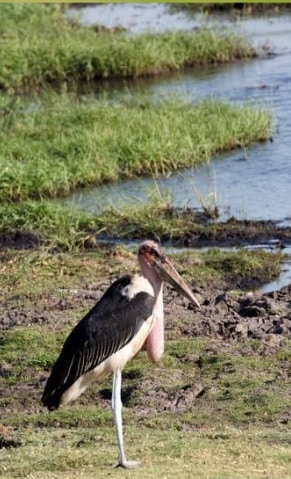
The Marabou Stork Family Life: Mating to Maturation
I’m fascinated by the family dynamics in the animal kingdom, and Marabou storks have quite an intriguing story. Their mating season is an annual event, during which these birds display a variety of behaviors to attract a mate. You’d see them clattering their bills, puffing up their throats, or performing elaborate dances to woo potential partners.
Once a pair is formed, they stick together to raise their brood. They often choose tall trees or artificial structures to build their large, messy nests. Females usually lay two to three eggs and both parents take turns incubating these future hatchlings.
Watching marabou stork chicks grow is a remarkable process. They start out completely defenseless, relying on both of their parents for food and protection. For the first fifty days, they stay close to the nest, being fed regurgitated food. But as they grow, they venture out, gaining independence and learning the skills needed for survival.
Parents are invested in their offspring’s upbringing. When food is plenty, marabou stork parents are diligent providers, but they’re quick to encourage independence when the time is right.
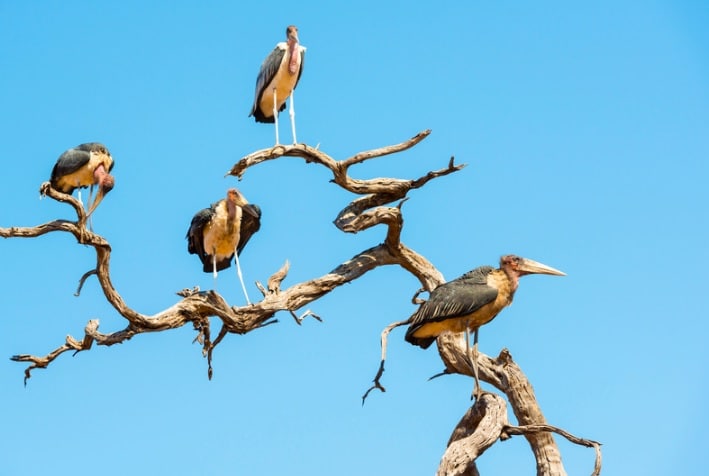
During times of scarcity, these birds can be rather ruthless, often favoring the stronger chicks to ensure survival of the fittest. This may sound harsh, but it’s a natural strategy that has ensured their species’ success over millennia.
Beyond the Birds: The Marabou Stork’s Role in Ecosystems and Culture
The marabou stork is more than just a bird with an unusual appearance. It plays a significant role in its ecosystem, acting as a natural cleanup crew that keeps the environment balanced. Interestingly, it forms a peculiar relationship with bees.
The storks have been observed standing near beehives or active beehive trees. The bees are busy collecting nectar and pollen, and during this process, some bees inevitably drop or lose their cargo. The opportunistic Marabou Storks take advantage of this by catching the falling bees mid-air or picking them off the ground. This behavior provides the storks with an additional food source without causing harm to the bees.
This interaction illustrates commensalism because the Marabou Storks benefit by gaining access to a supplemental food source (the bees) without causing significant harm to the bees themselves.
Culturally, this bird has been both revered and misunderstood, sometimes characterized in folklore and emblems, other times viewed warily due to its scavenging habits. Its presence in art, mythology, and sometimes as a symbol in conservation efforts highlights its impact on human culture over time.

The Marabou Stork: conservation status;
The Marabou stork (Leptoptilos Crumenifer) is not globally classified as a threatened species by the International Union for Conservation of Nature (IUCN). It is listed as a species of “Least Concern.”
This designation suggests that, on a global scale, the Marabou stork is not facing immediate significant threats that would warrant a higher conservation status. This is probably due to that they are scavengers and this kind of food is available everywhere.
More FAQs on the Marabou Stork.
As I write my articles, I keep an eye on any other questions that people might ask on search engines and try to answer them, so here we go:
Why are Marabou Storks called “undertakers”?
Marabou Storks are sometimes colloquially referred to as “undertakers” due to their distinctive appearance, which is reminiscent of the traditional image of an undertaker or mortician. Several features contribute to this association:
- Black and White Plumage: Marabou Storks have predominantly white plumage, which gives them a somewhat ghostly or pallid appearance. The black and grey coloration is often associated with the clothing worn by undertakers or morticians.
- Featherless Head and Neck: The head and neck of Marabou Storks are mostly devoid of feathers and covered in wrinkled, pinkish skin. This bare skin gives them a unique and somewhat eerie appearance, similar to the uncovered face of a mortician.
- Large Size: Marabou Storks are large birds with an imposing presence. Their size, combined with their distinct features, can contribute to the perception of solemnity, further reinforcing the comparison to undertakers.
Why do they belong to the “ugly five”?
The “Ugly Five” is a term that refers to a group of African animal species, including the Marabou Stork, that may be considered less conventionally attractive by human standards. The Ugly Five also typically includes the Wildebeest, Warthog, Hyena, and Vulture.
Marabou Storks are sometimes considered less attractive due to their distinctive features, including a featherless and wrinkled head, large size, and scavenging behavior. The exposed skin on their heads serves practical purposes such as preventing soiling during feeding and aiding in temperature regulation
Do Marabou storks eat baby flamingos?
In certain circumstances, a Marabou Stork might opportunistically consume the young of various bird species if the opportunity arises. However, this behavior is not specific to flamingos and is not a primary aspect of their diet.
Does the Marabou have predators?
Adult Marabou Storks, with their large size and powerful bills, do not have many natural predators. They are less vulnerable to typical predators due to their formidable presence. However, juvenile Marabou Storks may face threats from large carnivores or birds of prey. Additionally, human activities such as habitat destruction, disturbance, or hunting can indirectly impact Marabou Stork populations.
What is the lifespan of Marabous?
The lifespan of Marabou Storks (Leptoptilos crumenifer) in the wild is typically around 25 to 30 years.
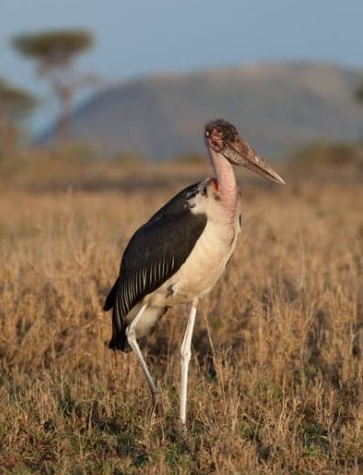
My Final Conclusion.
I hope that I have provided you with enough facts about the Marabou stork, but if you have any more questions, please feel free to leave them down below in the comment section or join me on my social media channels below to follow me on my adventures to the African continent!
I wish you happy travels!
Kind regards,
Lizzy
I now have a YouTube channel as well!
YouTube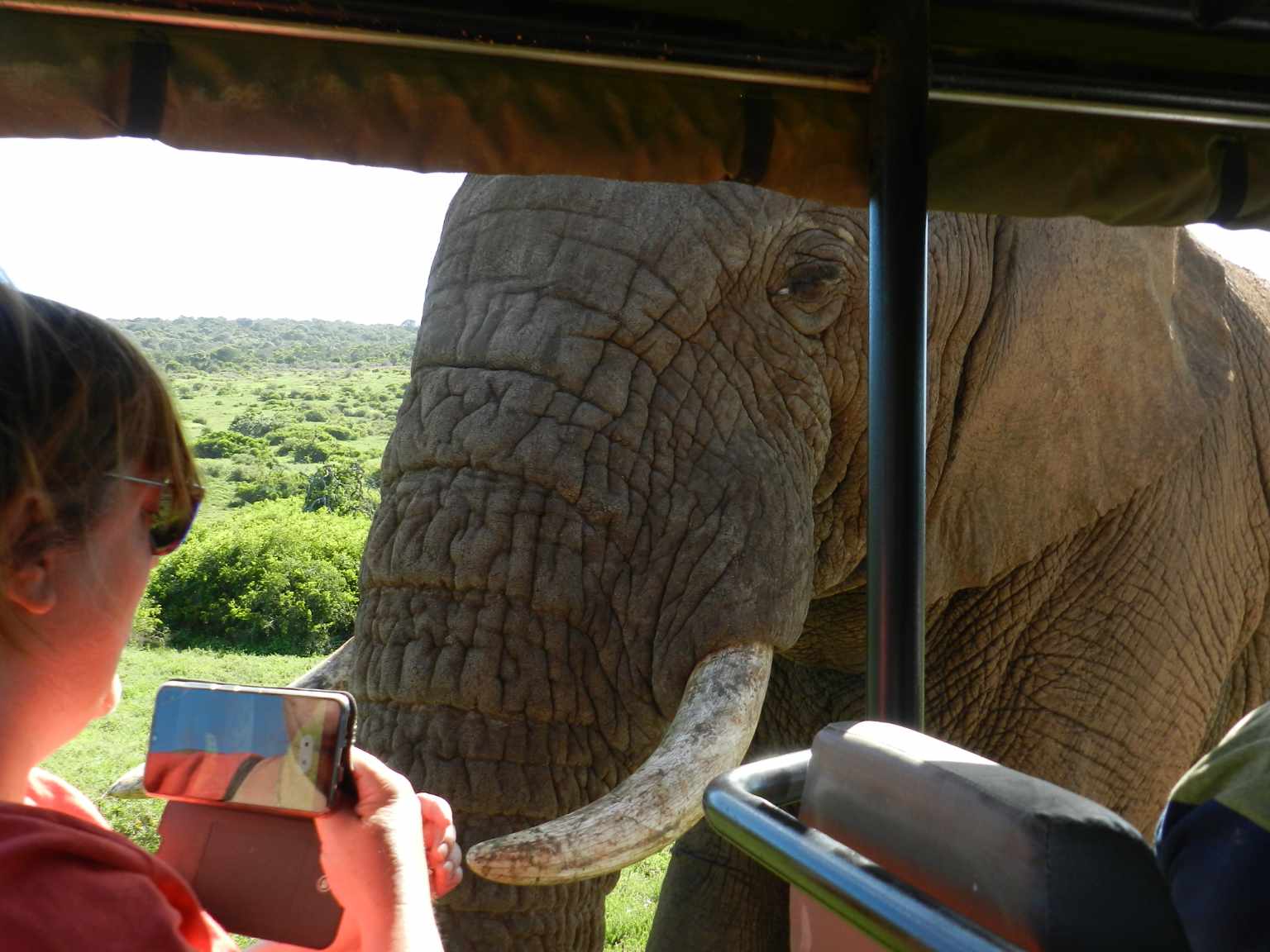
Hello Africa travellers!
Who am I? Well, the least you can say is that I am quite crazy about Africa, its nature, its climate, its culture, and more.
As a young woman in my twenties, I had already traveled to several African countries by traveling along in an overlander on my own and mostly camping ( or glamping ) and just fell in love with the diversity of it all.
So much, so that at the age of 26, I went back to university to study biology, which, unfortunately, I couldn’t finish because of health reasons (yes, I got sick from a tropical disease, oh cynicism). But this did not stop my dream of traveling back to Africa several times, and I still do.
My dream was back then to leave Europe and go study animal behavior, especially the elephants (sure, that’s every girl’s dream haha), but I am also very much intrigued by hyenas and other “ugly African animals“.
So, I “kind of” have a little bit of a scientific approach to my articles, when I write about African birds, for example. And most of all: the passion.
But life goes on, you move from one side of the country to the other, you get sick again and top it off with lower back problems, and before you know it, you are over 50 hahaha!
Now, I still travel to Africa, but take it a bit “easier” than the good old camping days, and stay in comfortable, yet affordable accommodations, together with my husband Wouter.
These are some of the countries I have traveled to: Kenya, Tanzania, Zanzibar, Malawi, Zambia, Zimbabwe, South Africa, Namibia, Botswana, Tunisia, and a little bit of Lesotho LOL .
While clearly not being African territory, but Spanish, I also visited Gran Canaria and Tenerife, and location-wise, I consider them “African”, because of their climate and nature, sue me :-p
The last trip I took was to South Africa in the year 2023, and it sure got the fevers for Africa back! From the Barberton mountains to the Drakensberg and the Southcoast, one month wasn’t enough at all to see the whole country, so we’ll be back! At ease and with a little bit more luxury than in my younger days haha!
I wish you happy travels!
Kind regards
Lizzy

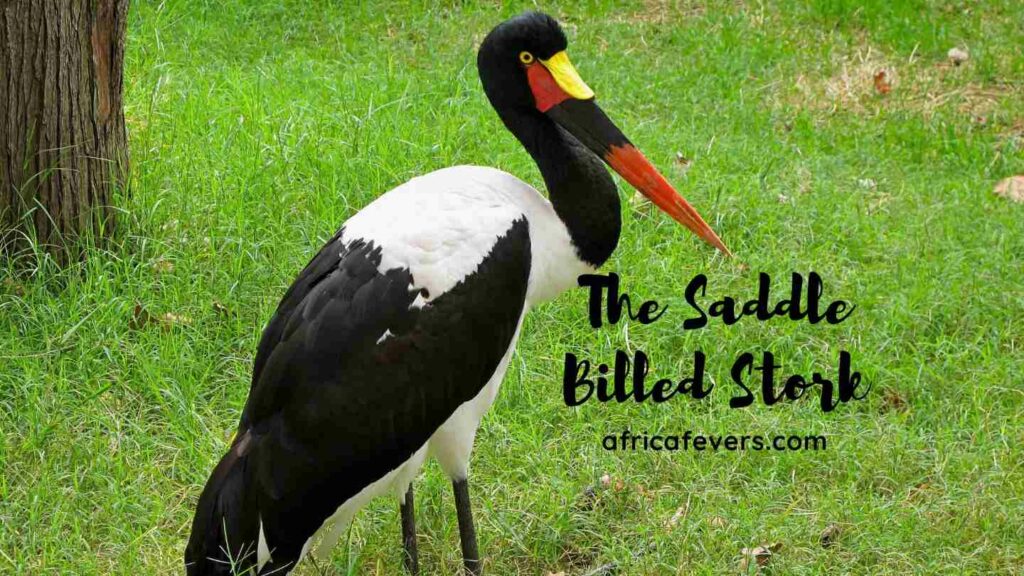


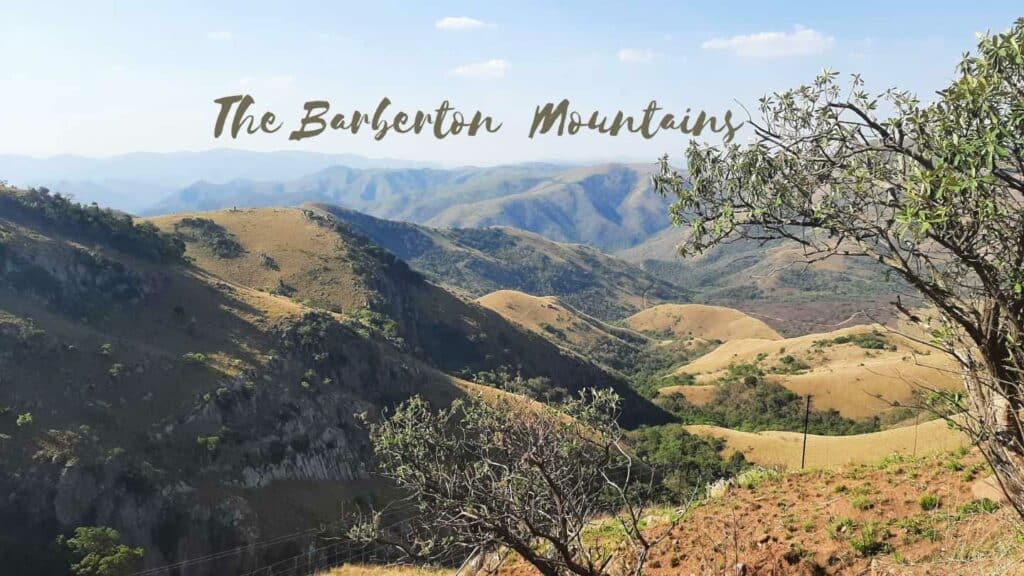
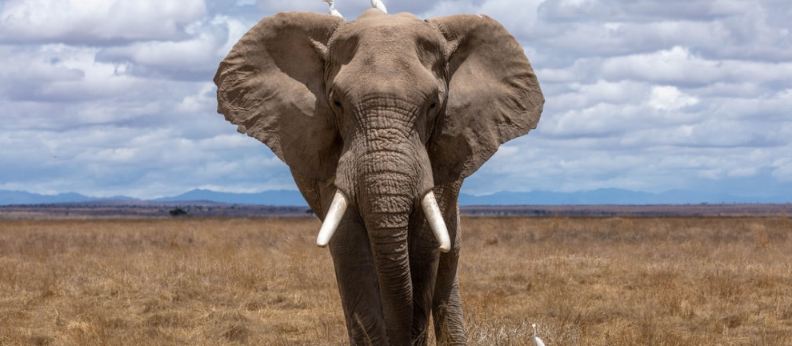
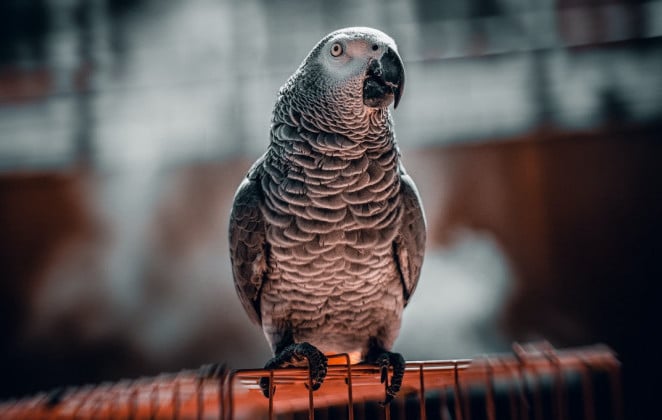
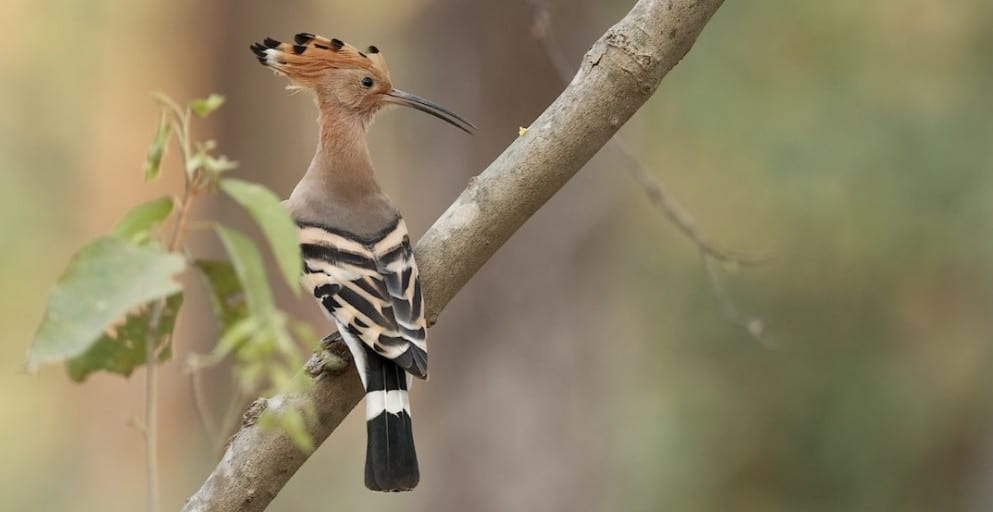

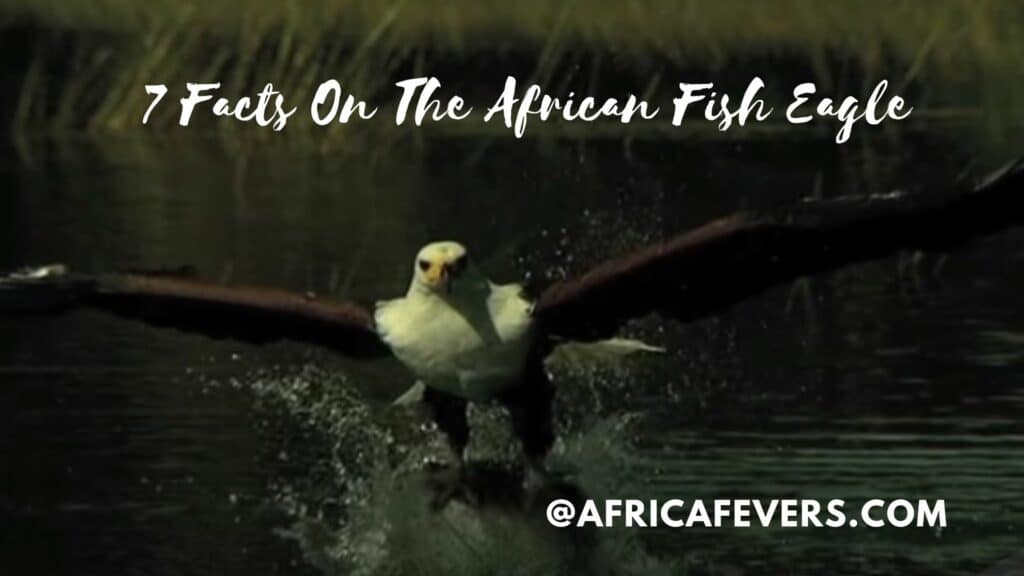

Lizzy, your article on the Marabou Stork is a treasure trove of information and a fantastic read for anyone interested in wildlife. You’ve done a wonderful job of shedding light on this unique bird, often overlooked due to its unconventional appearance. Your discussion about the Marabou Stork’s diet and role in the ecosystem is particularly enlightening, revealing how these birds contribute significantly to their habitats. Also, the cultural insights and the mention of their conservation status add depth to our understanding of the Marabou Stork’s place in the world. Excellent work! Looking forward to more of your wildlife adventures.
hello there!
Thank you very much for your uplifting comment and I wish you happy birdwatching!
Lizzy
I never realised a stork could grow to that size. And for the uninitiated, some might mistake it for a type of vulture with the baldness plus size. This was ome great information that I wasn’t aware. And such an adaptable bird with the different environments there can be found in too, wow.
I’m interested to know what valuable part does that sac play during the mating season though? Obviously, the bright colours are to attract mates, but what role has the sac?
Also, you say the parents stay together to raise the chicks, do they become monogamous like some other birds you have covered?
Another fantastic article, love reading these, keep it up!
Hello Ryan!
Thanks again for your support, it is always nice to see you here!
About your questions:
– Dorsal and ventral air sacs under the skin, which can expand, play a big role in how Marabou storks socialize. When the ventral pouch puffs up, it’s a sign that an individual is asserting dominance over its neighbors.
On the other hand, if the dorsal pouch inflates, it’s a clue that the stork is feeling a bit uneasy. Interestingly, during courtship, both pouches puff up at the same time. This is al interesting information for biologists and researchers of animal behavior.
– Marabou Storks are monogamous indeed as well, as most birds are, and form a pair for life.
Good questions,thanks!
Lizzy